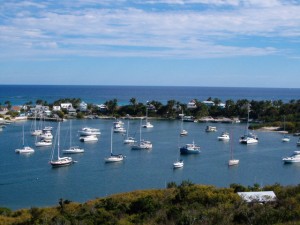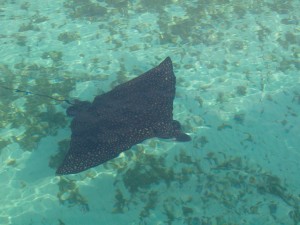What is the Bahamas Like?
Being Christmas time I thought I would log a short post providing a general description of what life is like in the Bahamas.
The Bahamas is an archipelago that spreads over about 500 miles. If you want to get an idea of the geography of the Bahamas, you can click here. We are cruising in the area called the Great Abaco, the northern most chain of islands closest to Florida. This area is often referred to as “the top of the Bahamas.” The closest Bahamian island to Florida is actually Grand Bahama Island which is not considered part of the Abaco island chain. On the western most point of Grand Bahama Island is a little town called West End. This is where we checked in with Bahamian customs and immigration.
Most of the TV commercials that advertise vacations in the Bahamas show images of big Hotels, Casinos, and water parks where the large cruise ships often dock; for example, the big tourist spots of Freeport and Nassau. The Abaco area is nothing like this. It is very rustic.
The “Out islands” of the Abaco are separated from the Great Abaco main island (where Marsh Harbour is located) by the Sea of Abaco. This is where we cruisers spend most of our time. There are no large hotel resorts or high rise condos in the Abaco. In fact we haven’t seen any buildings over 3 stories tall. If you want to see a detailed map of the Abaco Islands click here. We will eventually visit most of these islands in our boat; however our home base, where we will go to re-provision, fuel up, and get water, is in Hopetown on Elbow Cay. We chose Hopetown because it is one of the best natural harbors in the Abacos for protection against heavy weather.
The entire Bahamas has a total population of about 300,000 people. About 270,000 of this total live in Nassau. Only about 12,000 to 15,000 live on all the islands of the Abaco area. And probably 10,000 of this total live in Marsh Harbour, the capital city of the Abaco area. As a result there is very little “economy of scales” when it comes to public services. Electricity in the Abacos is very expensive; we pay $0.75 per KWH in our marina. Being just a large rock with occasional outcrops above the sea level, the Bahamas has no natural underground fresh water like in the US. All fresh water is obtained from rain that runs off building roofs into large tanks called cisterns (which are located either behind or underneath houses) or from reverse osmosis; the process of converting salt water to fresh water. This water does not taste as good as Deer Park Spring Water, but it is fine to drink. You can get Deer Park Spring water here if you want to pay $3.50 per gallon. Local water costs about $0.30 to $0.35 per gallon. Being very expensive in the Bahamas, fresh water is never free; except perhaps at an upscale restaurant. As a result everyone is very conscious of their water use.
As you might expect communications in the Bahamas is not as easy as in the US. US cell phone service does not work in the Bahamas. There are some telephone landlines in each island’s village area and there is some cell phone service if you buy a Bahamian cell phone. But in practice most cruisers use the VHF radio. This radio frequency is used to call other boats, restaurants, or to someone’s home on land. There are no house numbers on residences, only house names just like boats. People call each other by hailing their house or boat name. Until about 4 or 5 years ago, there was no WiFi service in the Abaco. You had to go to an “internet café” to get online. Now most restaurants and marinas have free WiFi. Because of this WiFi service, it is now much easier to email or call the US using the Skype service.
Almost nothing is made locally in the Bahamas, so most items, from computers to windows, to petroleum to food products or boat parts are imported, mostly from the US and Britain. For most of the local population, there is no income, sales, or property taxes, so most imported items have a significant import duty attached to them (as much as 100% duty). These import duties provide the bulk of the funds that runs the Bahamian government, but, as a result, everything is very expensive here compared to the US.
Since the Abaco population is spread out among islands, water transportation is very important. Many locals have a small power boat. If not, they use the extensive ferry system when they need to get to another island. There are very few cars in the Abaco and most of them are located on the main island around Marsh Harbour. Believe it or not, there is only one stop light in the entire Abaco island chain (located in Marsh Harbour). Most residents of the Abaconian out islands get around on land by golf cart, bicycle, or by foot. Except for perhaps a local business owner, there is virtually no truck or car traffic in the out islands.
After reading all this, some may wonder “Sounds pretty primitive, why are you there?”
As the saying goes, “A picture is worth a thousand words.” The adjacent pictures should cover a few thousand words (click on pictures to enlarge). The pictures should make it clearer why we come to the Bahamas.
One last thing about the Bahamas is the weather. George Washington did some surveying early in his life before leading the US revolution against the British. He referred to the Bahama Islands as the ‘land of eternal spring.’ I would have to agree with this assessment. Because the area is surrounded by water, the temperature band is very tight. In the winter months (when most cruisers are here), the average daytime high is 75 degrees Fahrenheit and average nighttime low is about 65 degrees Fahrenheit. You never need any heat or A/C. This weather lasts about 8 months. It does get hotter in the summer months (75 low to 88 high), but there is always a breeze and most days feel cooler than the same period in Maryland where we are from.
But the weather is not the overarching reason we come to the Bahamas; after all you can get similar weather in parts of Florida, it is the people and the lifestyle that appeals to us.
You will learn more about the people and the lifestyle in future posts.
Did you enjoy this post? Why not leave a comment below and continue the conversation, or subscribe to my feed and get articles like this delivered automatically to your feed reader.








Just got back from usvi and am already miising it. Enjoyed reading your posts immensely. Also love the pics. Carol